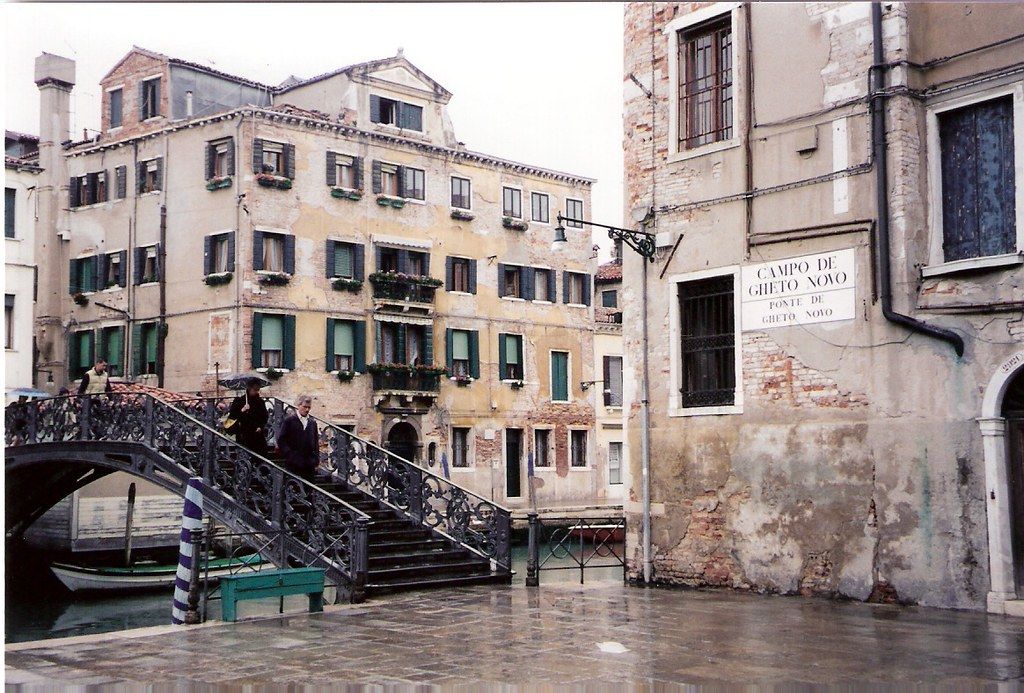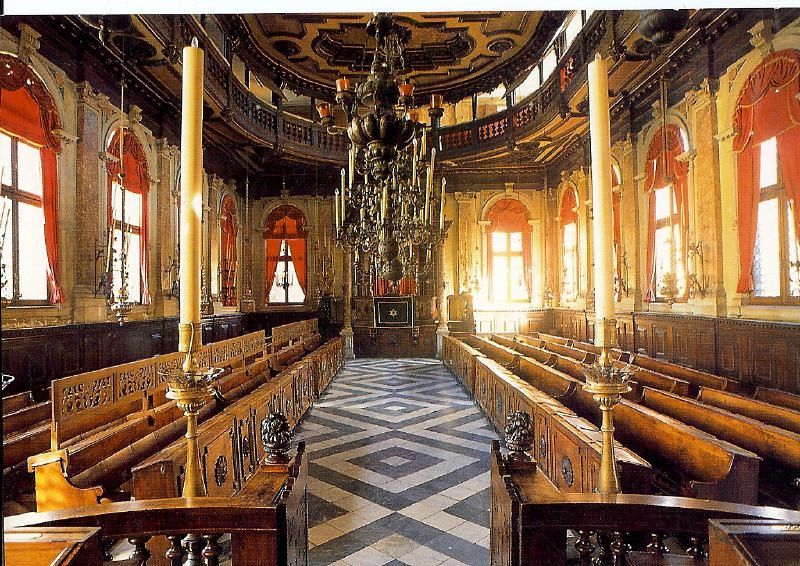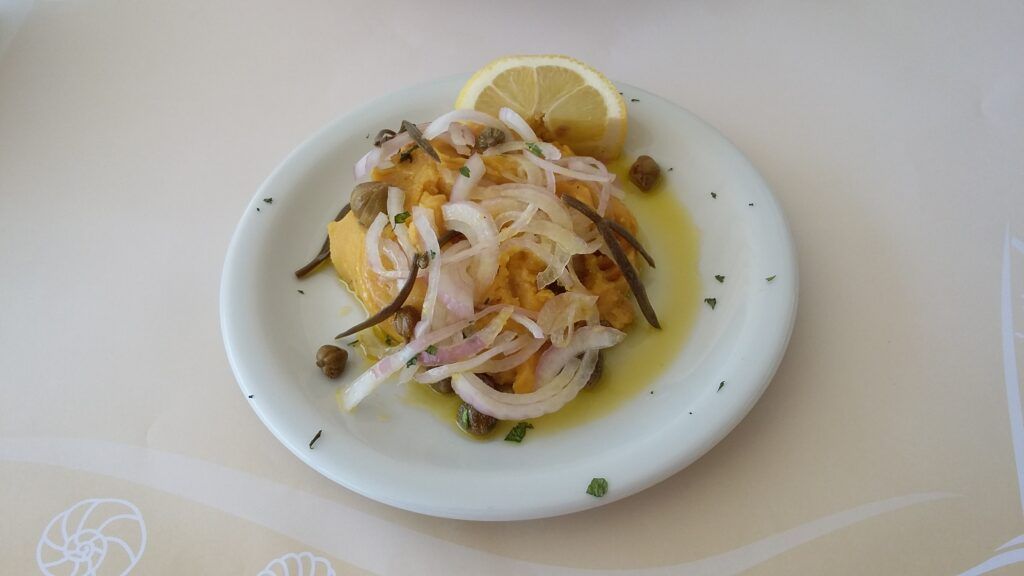After you exit from the Venice Santa Lucia station and continue along Strada Nuova, you should turn left after the Guglie bridge. On the right, a sottoportego (a passageway that goes underneath a building) opens up. It is the entrance to the Jewish Ghetto of Venice, the ancient area of the city where Jews lived from 1300 until the Second World War.

In this area, initially, there were Venice’s foundries (ghetto derives from the Venetian word “géto” which means to cast). Later this island was granted to the Jews in 1300, expropriating it from the families that lived there and thus allowing this minority to become part of Venice’s social and economic life.
What to see in the Jewish ghetto in Venice
The Jewish ghetto of Venice is divided into three areas: ghetto vecchio (old ghetto), ghetto nuovo (new ghetto), and ghetto nuovissimo (newest ghetto). In reality, despite the misleading name, the ghetto nuovo is the oldest one where the first Jews from Central Europe, the Ashkenazim, settled. The ghetto nuovo is located on an island surrounded by canals, like most of the 124 islands that make up Venice, connected to the rest of the city by bridges.
During the time when the ghetto was still a segregated neighborhood for the Jewish minority, the bridges were closed with gates at midnight and reopened in the morning. Later, new groups of Jews arrived in the city – Italians, Ponentini (from Spain and Portugal), and Levantini (from Greece) – which led to a progressive increase in the ghetto’s population until it became saturated, prompting the Republic of Venice to grant new spaces to the community. Therefore, the ghetto vecchio and the ghetto nuovissimo were established.
It is incredible to think that, at its peak, up to 5,000 people lived in this city within a city. In practice, each person had about 2/3 square meters! When visiting the ghetto nuovo, you will find yourself in a very large campo (campo is the name of the squares surrounded by buildings in Venice, in fact, the only square in the city that can boast this name is Piazza S. Marco). This is the heart of the Jewish ghetto and here are the oldest synagogues, the Jewish museum, pawnshops, and the homes of Venetians and students that once housed numerous Jewish families.
The Jewish museum
The Jewish museum can be visited for €10 and contains objects related to the religious life of the community, such as silverware, Torah scrolls, and drapes, texts in Hebrew, and especially informative signs that tell the history of the Jewish ghetto and the persecution of Jews from the origins to the Second World War, to the concentration camps. For €15, in addition to the Jewish museum, you can also visit three of the 5 synagogues of the ghetto accompanied by a guide. The presence of the synagogues might be overlooked by an inattentive eye.
In fact, these places of worship are carved inside pre-existing buildings, on the top floor of the buildings (there can be nothing above the synagogue). They can be recognized by the presence of 5 large windows aligned (5 like the books of the Torah) or by the Hebrew inscriptions on the walls. The oldest synagogue in the Jewish ghetto is the Todesca synagogue (or Schola). It is located in the same building as the museum. Furthermore, there is the Canton synagogue which is located at the corner of the square (canton in Venetian means corner), and finally, nearby there is the Italian Schola. In the ghetto vecchio, you can find the two most recent synagogues: the Spanish one and the Levantine one.

All the synagogues are not consecrated places, but simple places of aggregation where people regularly gather to read and comment on parts of the sacred book, the Torah. For the “meetings” to take place, there must be at least 10 men present, everyone can read a passage from the Bible, but only the rabbi can comment on them. The presence of women is welcome but not necessary. Women attend from a separate area from men, in a matriarchal loft, or separated from men by grates.
Today, there are still a few Jews who live in the ghetto, mostly because of the Second World War when most of them were deported to concentration camps across Europe. However, the traditions of this minority remain alive, and tourists can partly relive them through food. Just stop by the bakery to buy some typical Jewish sweets, or go to the Gam Gam Restaurant to taste the flavors of Kosher cuisine.
Interesting facts about the Jewish Ghetto in Venice
Sarde in saor is a typical Venetian dish, but it comes from the Jewish tradition, consisting of fried sardines seasoned with marinated onions, pine nuts, and raisins. In the ghetto, there was a certain rivalry between Jews of different origins, usually the Levantini (the last to arrive in the ghetto), who got residency much later after they settled there. Since the ghetto was already very crowded, the “original” Jews did everything possible, even with persistent letters to the Doge, to prevent the Levantini from obtaining residency permits.

The presence of Jews in Venice was of great interest to the Serenissima because they were shrewd merchants, and only they could lend money on pawns (a practice forbidden to Christians by religion). There were 3 pawnshops in Venice, all three overlooking Campo del Ghetto Nuovo: the red bank, the green bank, and the black bank, probably named after the color of the receipts they issued. But Jews could not accept anything as objects, such as weapons and religious items, which were prohibited by law.
And the last interesting fact is that the Torah read in the synagogue is strictly handwritten with natural ink and with special pens that have been passed down for centuries. Those who transcribe it have a sacred task and cannot make mistakes. Silver sticks are used to mark the point reached in the reading to facilitate the reading of the Torah in the synagogue.
Check out more articles about Italy:

